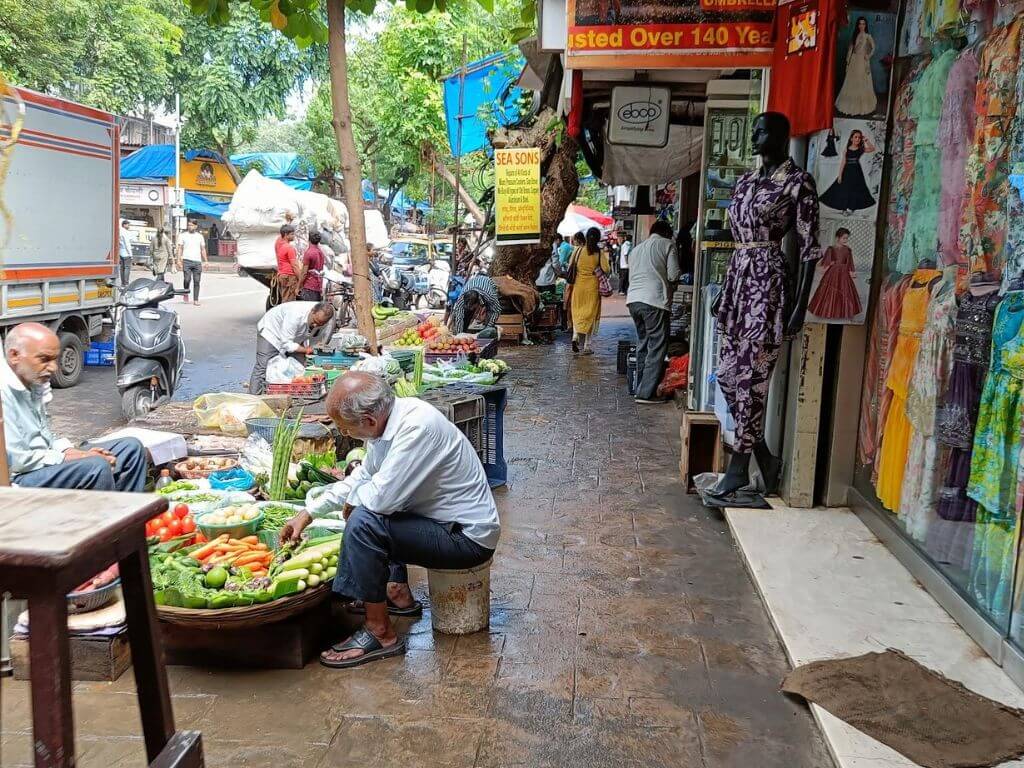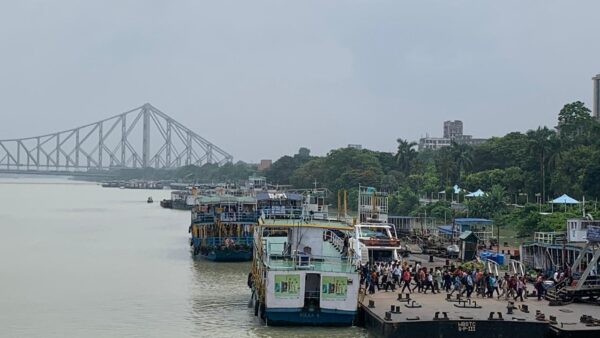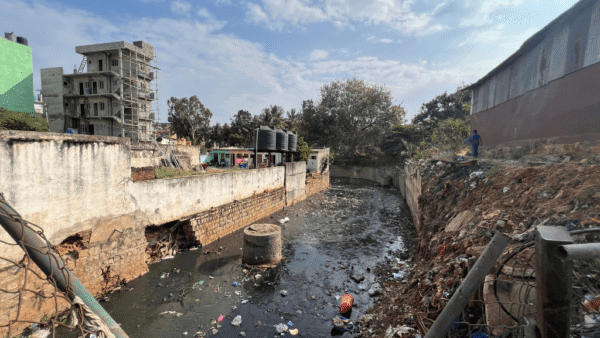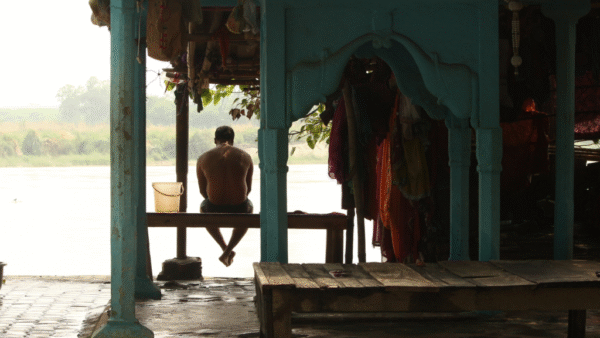We love to walk, as do many Indians. Walking is a cherished way for us to connect with the city at a human pace, to traverse the variety that Mumbai has to offer. We enjoy witnessing people as they go about mundane daily tasks – office-goers, newspaper boys, fish sellers, cobblers, or chaat vendors. This, while petting the cats perched up on several compound walls, taking in the city’s myriad scents from the aroma of freshly baked cakes to the allure of roadside Chinese food, mingled with hints of detergent and the pungency of rotting discarded vegetables. Walking allows us to marvel at the frontend of the city’s economy, as the tech enthusiasts would describe it.
We perhaps romanticise walking. For most people in the city, walking is primarily utilitarian, to be avoided as much as possible, and with good reason. The walking environment is not great at all. Most walking spaces are narrow, congested, fractured, cacophonous, grimy, stressful, and dangerous; more so for children and the elderly as well as the physically challenged.
In Mumbai, 51 percent[1] of transport trips consist solely of walking. When paired with trips to use public transport, this percentage increases. Most people in the city, even those who use private cars, navigate its pedestrian infrastructure at some point during their daily lives. Despite such heavy use, minimal attention is given to the building, maintenance and renovation of these crucial walking spaces.
Take the suburban railway station areas. Walking is the primary means of entering and exiting them. Approaching any of the 150-odd railway stations across Mumbai’s suburban railway and hundreds of bus stops or depots is an unpleasant experience, to say the least. The paths are congested, unclean, and require pedestrians to dodge vehicles, making them outright dangerous to approach if not merely unpleasant. This negligence is in stark contrast to the higher priority given to the more capital-intensive road and metro rail projects.
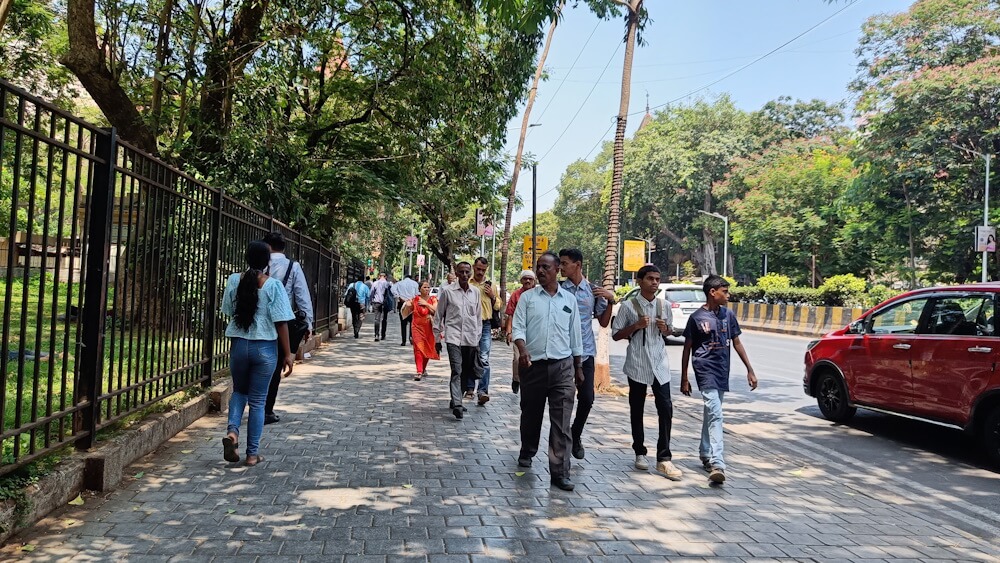
Across most neighbourhoods in Mumbai, especially those developed post-independence, pedestrian experiences are plagued by many issues. Footpaths are narrow, discontinuous, uncomfortably high, lacking proper edge slopes, and often flanked by extensive and restrictive guardrails. They are frequently encroached upon by hawkers, offer inadequate shade against the elements, are devoid of street furniture and relief areas, burdened by utility boxes and cabling that poses trip hazards. Often, all these challenges coexist.
However, several streets heavily frequented by pedestrians remain open for vehicles to cruise through, forcing pedestrians to perilously navigate around the vehicles amid heavy foot traffic and incessant honking; Ranade Road in Dadar West or the streets around Crawford Market are examples. This disregard for pedestrians itself amounts to neglect.
The Walking Project began as a collective to do advocacy for a pedestrian-first Mumbai. We started by conducting audits, proposing pedestrian improvement measures, and later expanded our efforts to include creating and promoting pro-pedestrian media content to reach the public. The city cannot be a sustainable, future-ready city if it is not a walkable city.
Case study – Andheri
Mumbai’s Andheri suburb, spread out across the east and west of the railway line, is among the largest and most dense in the city in terms of population and commercial activity. Once a sleepy outskirts of the island, it is now a hub of services sector, entertainment companies, studios, small businesses, vast malls, shopfronts, thousands of housing complexes, schools, colleges, and hospitals. On the other side, in Andheri East, is the international airport, the software exporting hub SEEPZ besides five-star hotels and headquarters of companies.
We chose a neighbourhood in Andheri West with a route along the Metro Line 1, which runs east-west, connecting the far end of Andheri West across the eastern side to the Ghatkopar suburb. Our community walk followed the alignment from Andheri railway station to DN Nagar metro station, approximately a 2 kilometres stretch. The walking patterns in the neighbourhood predominantly radiate outwards from the nearest transit hubs.
At the exit at Andheri railway station (western side), we observed the absence of a cohesive system for the dispersal of pedestrians. The relatively pedestrian-friendly station devolved into a chaotic pickup and drop-off zone right outside it, without segregation of motorised and non-motorised transport which made it unsafe for pedestrians. Several level changes were necessary just to climb onto the nearest footpath. Infrastructure to aid the visually impaired and disabled was completely absent.
The footpaths widely varied in width, sometimes too narrow to accommodate pedestrians. This unevenness was compounded by the use of old-style loose tiles which made walking difficult where footpaths were wide enough. Additionally, excessive installation of guardrails made the footpath too claustrophobic to navigate.
If this was not challenging, the infrastructure for pedestrians to safely cross the super-busy SV Road was absent – no pedestrian cycles in the traffic signals, no zebra crossings along the route, bus stops constructed mindlessly on the middle of the footpath, uncrossable road medians, and deafening traffic noise which at times made even communicating with the walk participants difficult. The DN Nagar metro station area, though a relatively new infrastructure facility, was a pedestrian’s nightmare. It lacked zebra crossings, had long signal wait times, no tactile paving, and kerbs without accessible slopes.
The route of our study was also occupied by hawkers with varying degrees of encroachment, sometimes requiring us to jostle past other pedestrians and sometimes forcing us to step onto the road carriageway amidst vehicles where the pavement width was occupied.
The participants expressed deep dissatisfaction with the pedestrian environment along the entire route.
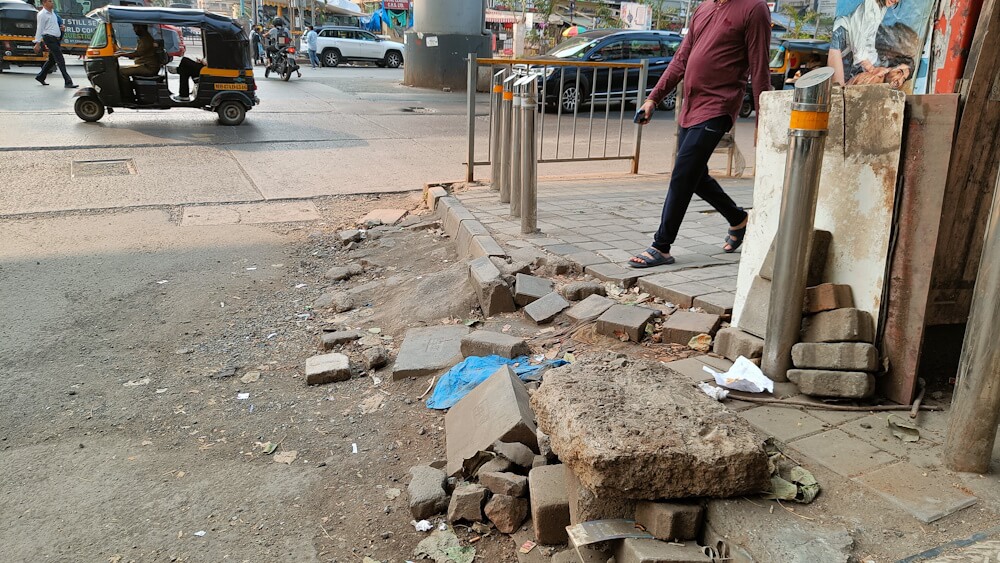
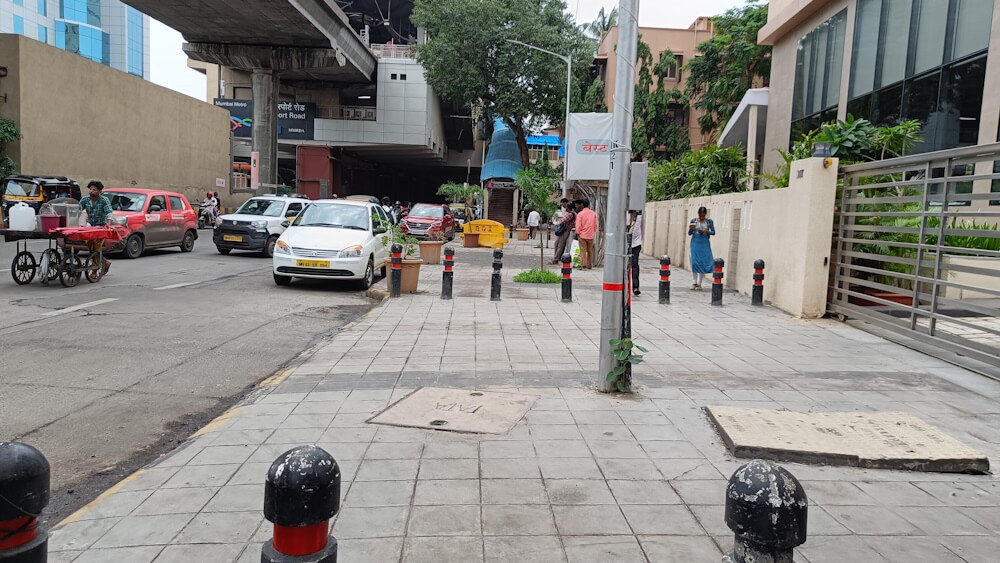
The possible solutions
A seamless pedestrian plaza spreading out from the railway station to nearby footpaths, accompanied by bollard-separated pickup and drop-off zones, could significantly enhance pedestrian comfort and flow. Examples exist at Bandra (west) and Thane suburban stations. Additionally, implementing a comprehensive system of tactile paving branching out from the station would dramatically improve accessibility for the visually impaired.
It is essential to renovate and expand the footpaths across the neighbourhood and significantly reduce the use of guardrails. The increasingly popular stamped concrete paving can facilitate better sloping and surface quality for the footpaths. Also, rationalising signal wait times, complete pedestrianisation of high footfall routes, and aesthetic enhancements to metro viaducts through simple paint should also be considered. The high noise levels generated by the viaducts call for measures such as employing noise reduction techniques like acoustic padding, paint, and planting vegetation.
A comprehensive improvement of junctions, especially those experiencing high foot traffic, is imperative. Implementing physical design interventions such as raised crossings, junction boxes, curb extensions at intersections, and visual design cues for cautious driving can transform this into a safer, more pedestrian-friendly neighbourhood. None of these suggestions are difficult to implement.
We saw a success story in the vicinity of the Marol Metro station, Andheri East, where segments along the arterial Andheri-Kurla Road have seen incredible improvements in the past two years. This transformation includes a significant expansion of the footpath width at and between the Marol and JB Nagar metro stations, setting a positive precedent which should be replicated.
Walkability and climate change
The dominant theme in this year’s annual climate summit, or Conference of Parties (COP28) has been the phase out of fossil fuels.[2] We can do this perhaps by prioritising reductions in fossil fuel usage, starting with conserving small amounts and scaling them up. The immediate transformation of our cities into spaces designed for people to walk and cycle would be an effective starting point.
While many place their hopes on EVs for emission reduction, it is essential to acknowledge the carbon-intensive manufacturing process behind zero tailpipe emission EVs. For instance, a Tesla Model 3 needs to be driven for 21,725 kilometres[3] before it eclipses a similar petrol car in terms of net emissions. Walking has zero emissions from day one. When combined with public transport operating on renewable energy, there can be a significant reduction of millions of tonnes of CO2 and greenhouse gases at source.
We are witnessing significant investments in road infrastructure projects across the Mumbai Metropolitan Region to alleviate traffic congestion but global trends show road expansion seldom improves congestion. Instead, it encourages private vehicle use, which will always be more carbon intensive per passenger transported. Instead, spend to make Mumbai walkable.
In downtown Churchgate or CSMT rail heads, one can walk for a kilometre or two joyously, with only a few obstacles. Meanwhile, in the northern suburbs, walking even 200 metres is a nightmare forcing motorised transport on people who would have otherwise walked. People who are creating the least emissions should be rewarded, not punished.
The shift towards environmentally sustainable cities centred on public transit and walking can significantly contribute to greener, more resilient cities.
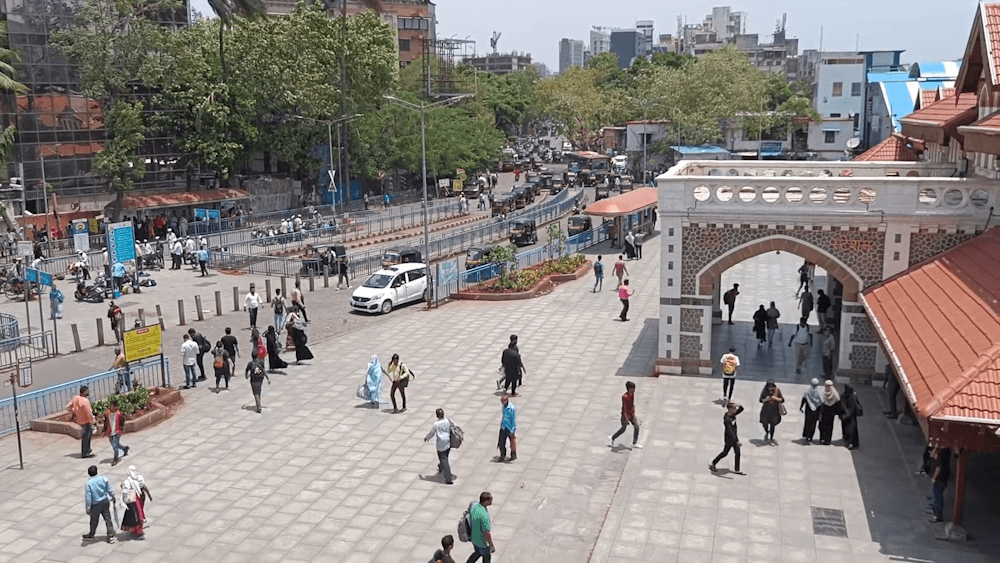
What Walking Project has done
As a pedestrian advocacy organisation, we primarily aimed to initiate discussions and, for over a decade, actively engaged with urban local bodies to improve pedestrian environments in different areas of Mumbai. We collaborated with 105 commercial units in the Marol area of Andheri suburb, drafted comprehensive actionable documents, held discussions with municipal officials, and advocated pedestrian issues in the media.
Our initiatives include Know Your Footpath[4] to educate people on footpath widths, comfort and space, and Walking Project x Mapillary[5] to map footpaths via open-source software so that walking challenges can be pinpointed through community-driven efforts. Our efforts have led to 24 kilometres of footpaths being mapped in Mumbai. We invite QoC readers to join in.
The Walking Project has tabled several pedestrian improvement programmes and comprehensive proposals to the Brihanmumbai Municipal Corporation (BMC). Contrary to popular belief, BMC officials have been remarkably open to our suggestions. However, the challenge lies in navigating the bureaucratic machinery to see these proposals through fruition.
Many ask if our initiative can extend to their cities indicating the need for pedestrian rights to be widely articulated. Our advocacy has achieved mixed success so far but our meticulous documentation continues and gives us confidence that our work can have a significant impact on walkability. Besides talent and equipment, as an advocacy group, we also need resources which have been inadequate.
A contentious issue that we found during our walks and online discussions is vendors occupying footpaths. The walking versus vending masks infrastructure shortcomings. Hawking, historically integral to city life, thrives in Mumbai but is not incorporated into urban planning or street design. Informal service providers like cobblers, vegetable vendors, and others provide invaluable services and bring secondary benefits to the city like affordable access to goods and added security at night. However, managing their presence in a pragmatic manner is crucial. Cities have addressed the contentious issue and Mumbai should borrow solutions.
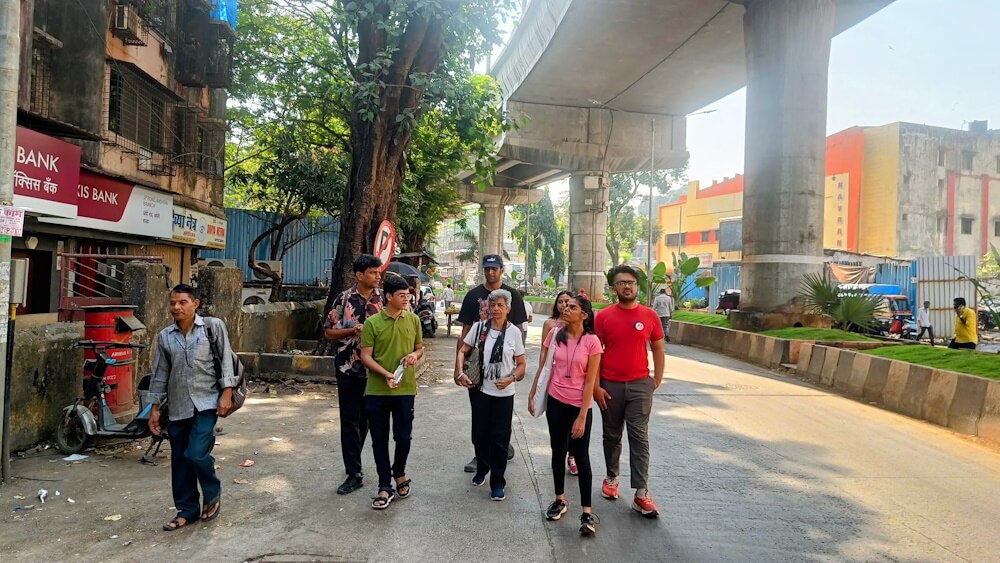
Walking and public transport are the future
Mumbai’s public transport, especially buses, have seen plummeting fleets and halved average bus speeds, which has made private transport attractive for point-to-point trips. But roads are saturated; Mumbai ranks as the 6th slowest metro area[6] globally in terms of road speeds. In a few years, road travel will be too time consuming. The city cannot possibly build highways and parking spaces to accommodate the 182 cars being added to our roads daily.[7]
Improving footpaths and focusing on quality public transit can significantly elevate average walking speeds. Upgraded pavements can also encourage the last mile trips to home for many on foot. Unlike roads, footpaths do not have to withstand the tonnes of vehicle weight and can easily last a decade with minor upkeep. Mumbai can draw inspiration from London or the Netherlands, where standardised pedestrian-first plan and road design guidelines ensure walkability improvements every time a street is revamped. Several hundred kilometres of Mumbai’s roads are being rebuilt. This plan could be aligned with policies mandating adequately wide footpaths and pedestrian-friendly junction designs. Enhancing walkability around the metro nodes can bolster its ridership.
Channelling resources into world-class walkable infrastructure integrated with high-quality public transport is a pragmatic alternative to private transport. The future of our cities hinges on a blend of walking and public transport.
Rishi Aggarwal, founder of Mumbai Sustainability Centre, spearheads initiatives like the Safai Bank of India dedicated to waste management, alongside leading the Walking Project. With an extensive activism record over two decades, he engages with communities on critical environmental and urbanisation challenges in Mumbai and the surrounding region.
Vedant Mhatre, activist with the Walking Project, passionately explores the complexities of the modern urban landscape, focusing on urbanism, transportation, and climate issues. Adept at crafting online campaigns to drive attention to urban challenges, he creates and uses informative videos on these topics to drive home the point. He holds a bachelor’s degree in Electronics Engineering.
Cover photo: A pavement occupied by a diverse set of stakeholders in Dadar, central Mumbai.
Photos: Vedant Mhatre

